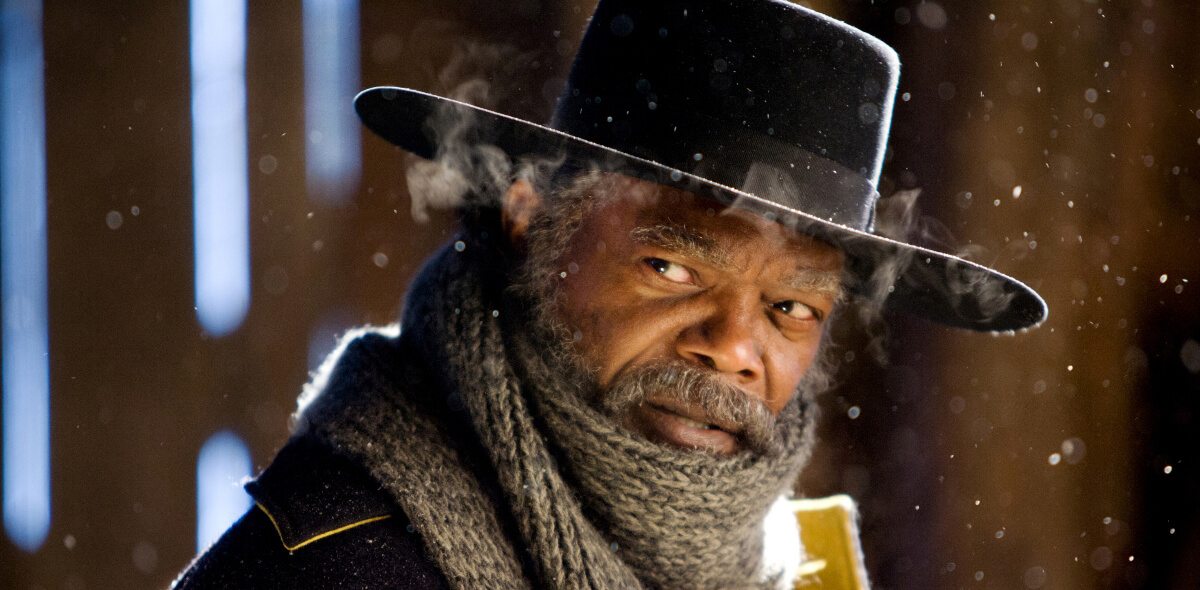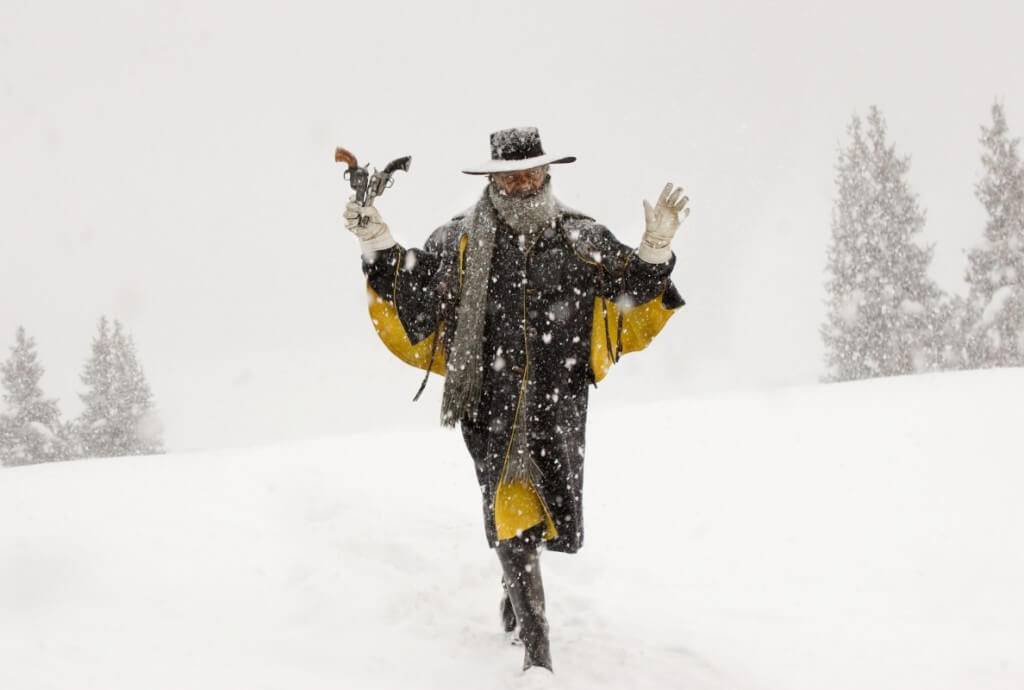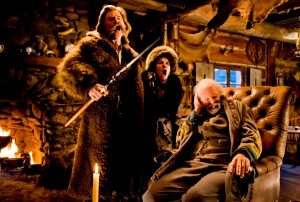The Hateful Eight
[dropcap]W[/dropcap]e first meet the full eight of the title in the secluded setting of Minnie’s Haberdashery, about 40 minutes or so into the running time of The Hateful Eight. They include the theatrically named ‘the bounty hunter’, ‘the hangman’, ‘the prisoner’, ‘the little man’, ‘the Mexican’, ‘the confederate’, ‘the cowpuncher’, and ‘the sheriff.’ With this line-up, and the title that seems to be a clear allusion the John Sturges’ The Magnificent Seven (1960), many initially expected something more in lieu with that brand of grandiose sweeping western epic for Tarantino’s eighth film. Moreover, with the announcement the film would be shot in 70mm Panavision with a super wide 2.75:1 frame, this seemed to be a foregone conclusion. Instead, we have here an isolated group of characters sitting tight in a ‘watering hole’ during a blizzard, and the knowledge that one of the characters is not what they say they are – it’s a chamber piece.
John ‘The Hangman’ Ruth (Kurt Russell) is transporting his prisoner Daisy Domergue (Jennifer Jason Leigh) to Red Rock to be hung. Before reaching Minnie’s Haberdashery he picks up a fellow bounty hunter Major Marquis Warren (Samuel L. Jackson), and a man claiming to be the new Sherriff of Red Rock, Chris Mannix (Walton Goggins). His introduction is almost directly lifted from another ‘snow western’, Sergio Corbucci’s 1968 film, The Great Silence. This is a film The Hateful Eight takes from most of all, and considering the visceral battleground of influences (all vying for attention) that create a Tarantino picture, this is no mean feat.
However, The Great Silence includes a mute in the lead role, and we can assume that such an affliction would be a cardinal sin in the richly dialogue laden Tarantino-verse. The ending of John Carpenter’s The Thing (1982) is mirrored (and anyone that delights in trivial pursuits of the filmic kind will surely appreciate Kurt Russell’s presence in this regard). Another influence that Tarantino has listed is Agatha Christie’s And Then There Were None (1939) and at its heart The Hateful Eight is a dynamic mystery. A clear feature of the film is Tarantino’s own past work, most notably Reservoir Dogs and Django Unchained. Perhaps more than any other film made by the director, watching The Hateful Eight in context as Tarantino film is essential.
So lets cut the pleasantries. The Hateful Eight is too long. The Hateful Eight is horrendously violent. The Hateful Eight is racist. The Hateful Eight is self-indulgent. The Hateful Eight is misogynistic. The Hateful Eight is typified by a lack of substance. The Hateful Eight is boring. The Hateful Eight is too entertaining considering the subject matter. If everyone could just pause for a minute and stop the relentless use of the copy and paste tool on your laptop we can establish what The Hateful Eight is not. The Hateful Eight is not straightforwardly any of these things. What it does do is address all of the above, in a self-aware and ever so slightly nihilistic fashion.
The idea that it has a fixed view on any of the above goes against the kind of film that Tarantino is making here, ambiguous and rich with detail. Not to say that some of the issues critics have taken with the film aren’t valid in many ways. A core debate surrounding the film’s release, similarly with most Tarantino films, is its overwhelming style and aesthetic bombardment of the audience. The still wide frames in The Hateful Eight create an atmosphere of distrust and the compelling ambiguous narrative encourages viewers to pay attention to every excellently staged detail. The film is also far more morally complex than other Tarantino films; this comes down to how despicable every single character is. They really are a hateful bunch.
On repeat viewings Tarantino’s detailed staging of the characters in Minnie’s Haberdashery becomes a kind of microcosm of American politics, purveying a disillusioned view of humanity as a whole
The Hateful Eight offers an interesting perspective on Tarantino’s recent strain of revisionist histories. What we have here, in the central symbol of the Lincoln letter, is Tarantino accepting an inability to correct sins of the past. It offers an interesting counterpoint to items imbued with mysterious power in his earlier films, the suitcase from Pulp Fiction being the best example. In this film he embraces a grim view of humanity thematically. A lot has been made of how the film reflects on issues of racism and the law in America today. On repeat viewings Tarantino’s detailed staging of the characters in Minnie’s Haberdashery becomes a kind of microcosm of American politics, purveying a disillusioned view of humanity as a whole.
Oh and its incredibly entertaining. Every performance is excellent (Tim Roth a standout comedic layered comedic role as Oswaldo Mobray). The craftsmanship is as always spot on, the dialogue as sharp as ever. Tarantino’s most racially engaged and thoughtful film, The Hateful Eight isn’t without the occasional misstep but there is more success in here than there is failure.
Director: Quentin Tarantino
Cast: Samuel L. Jackson, Kurt Russell, Walton Goggins, Jennifer Jason Leigh, Tim Roth, Michael Madsen, Bruce Dern, Demian Bichir
Running time: 167 minutes / 180 minutes (roadshow cut)
Country: USA
The Hateful Eight is showing at the Warwick Arts Centre until February 11th.



Comments